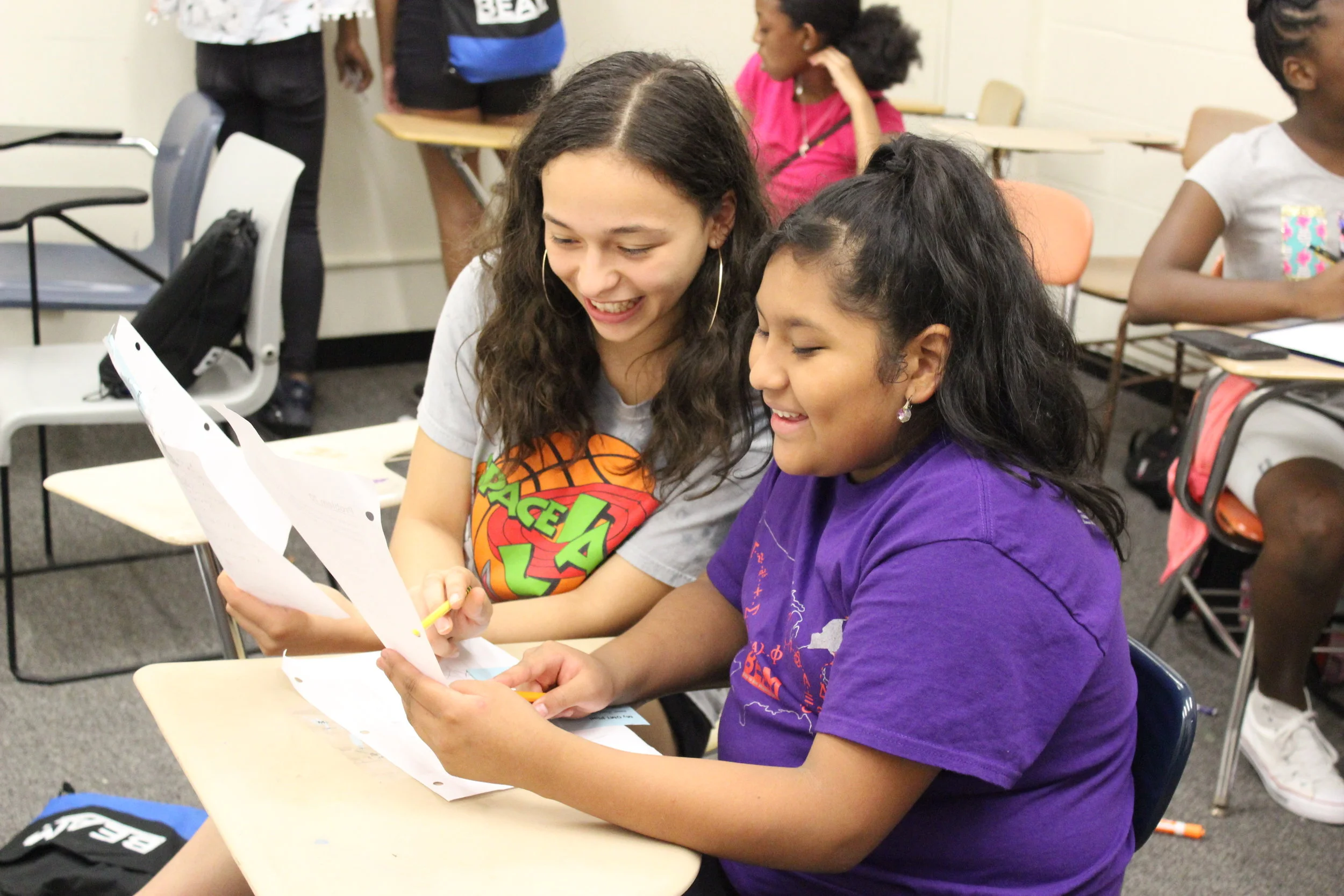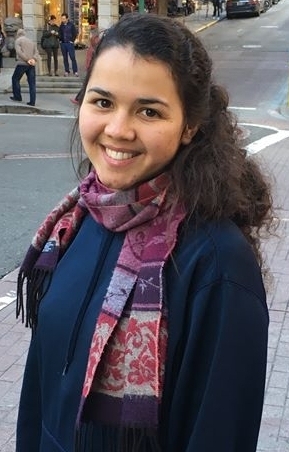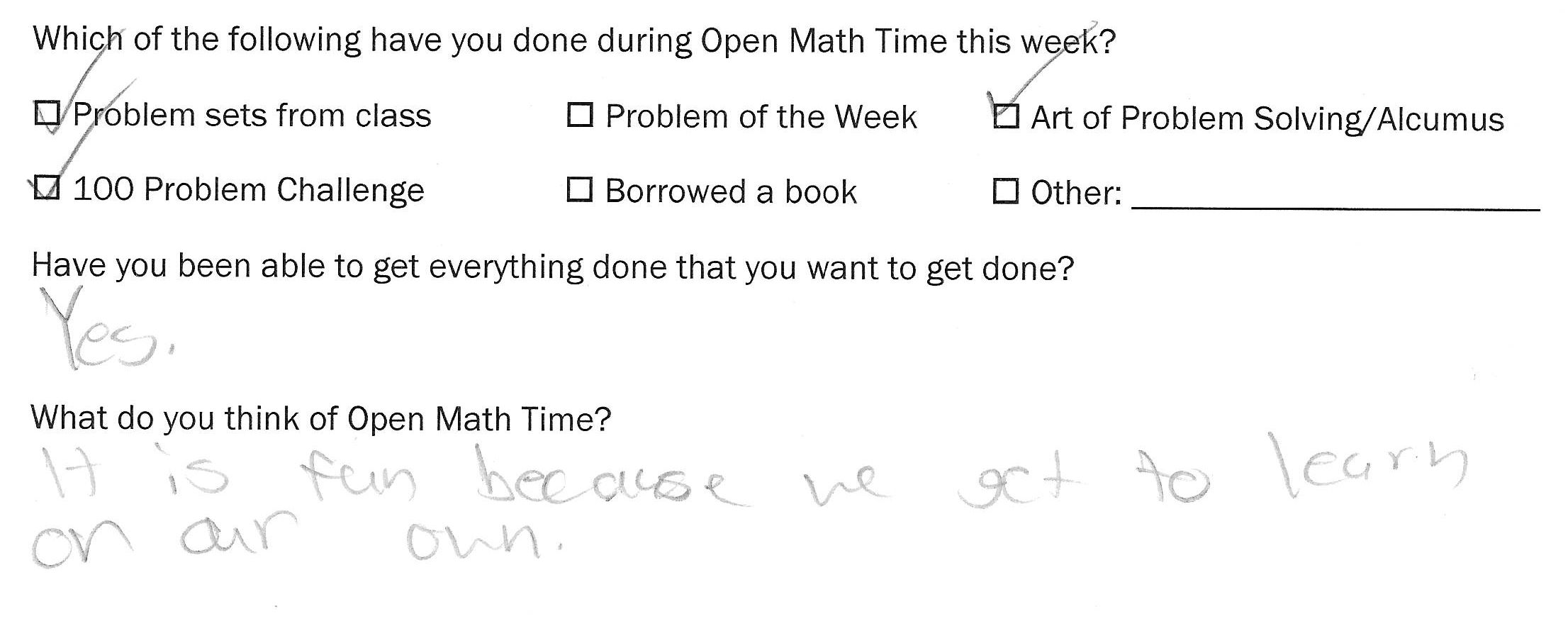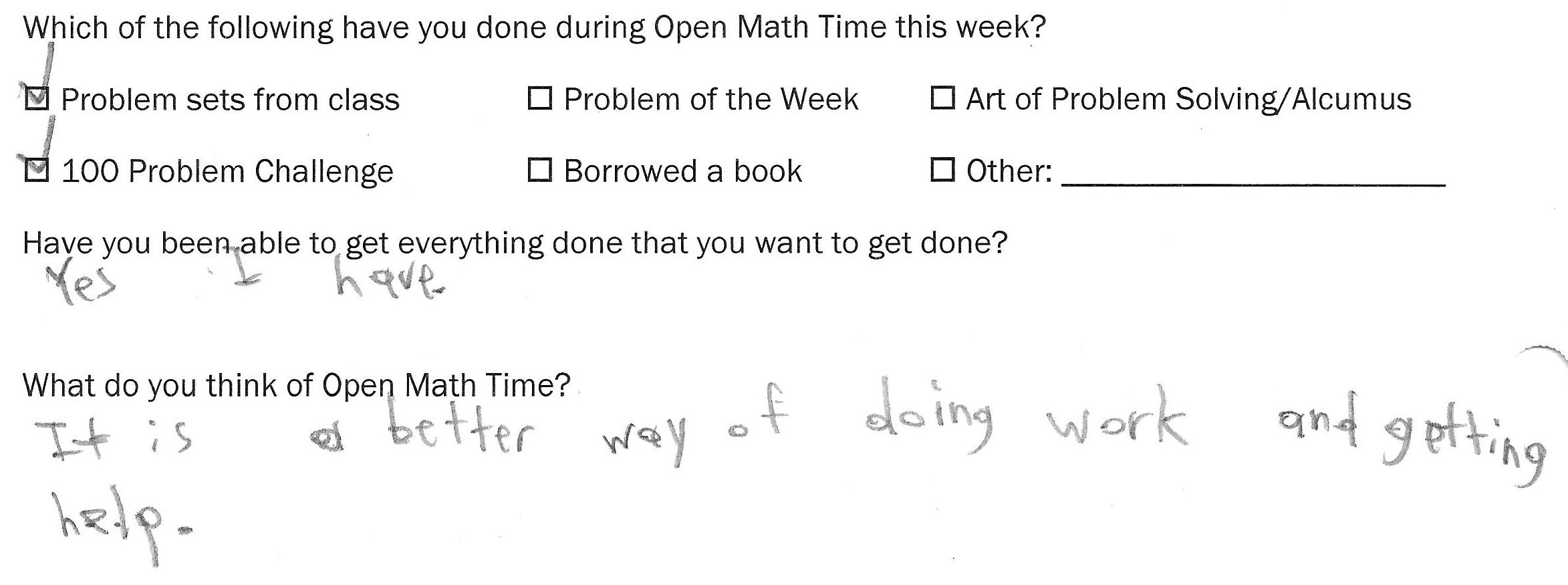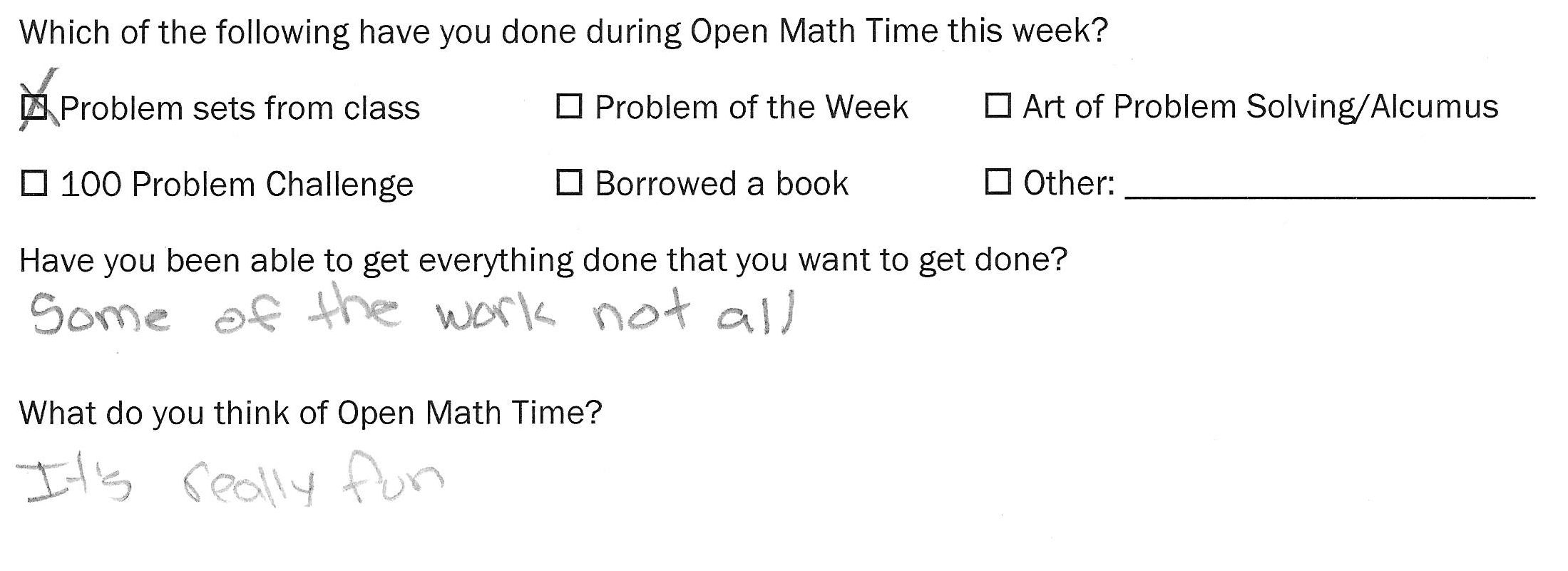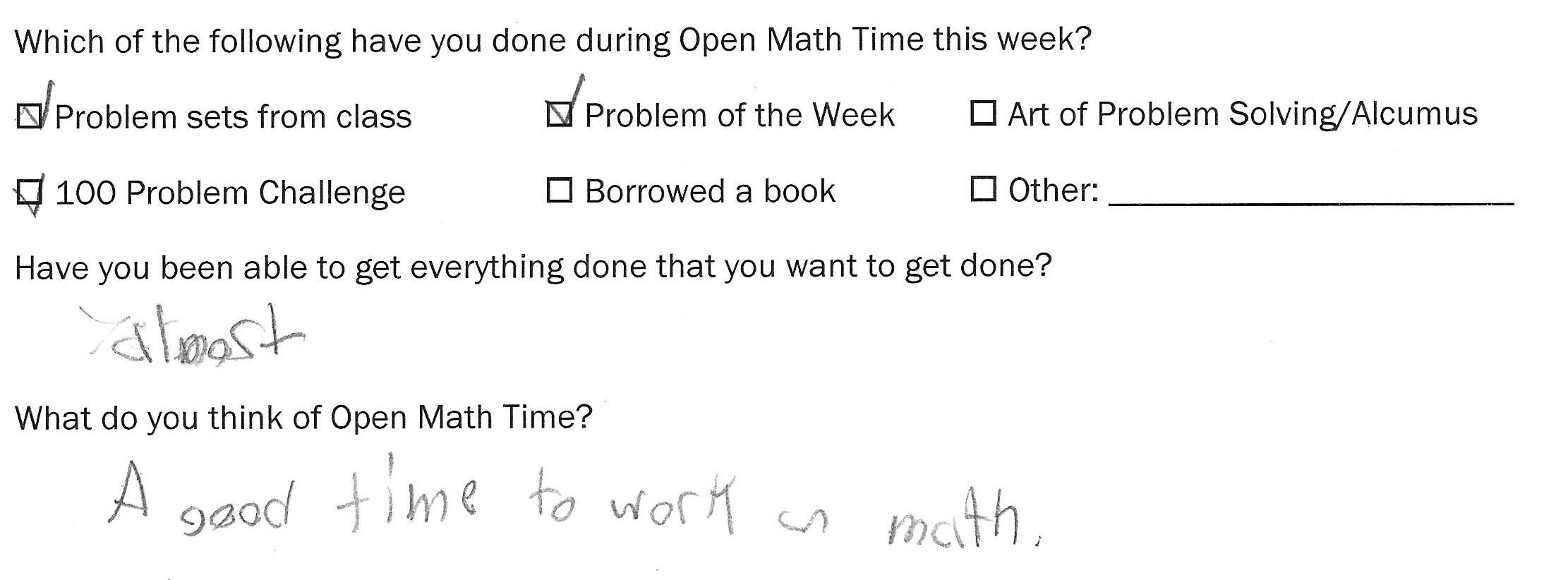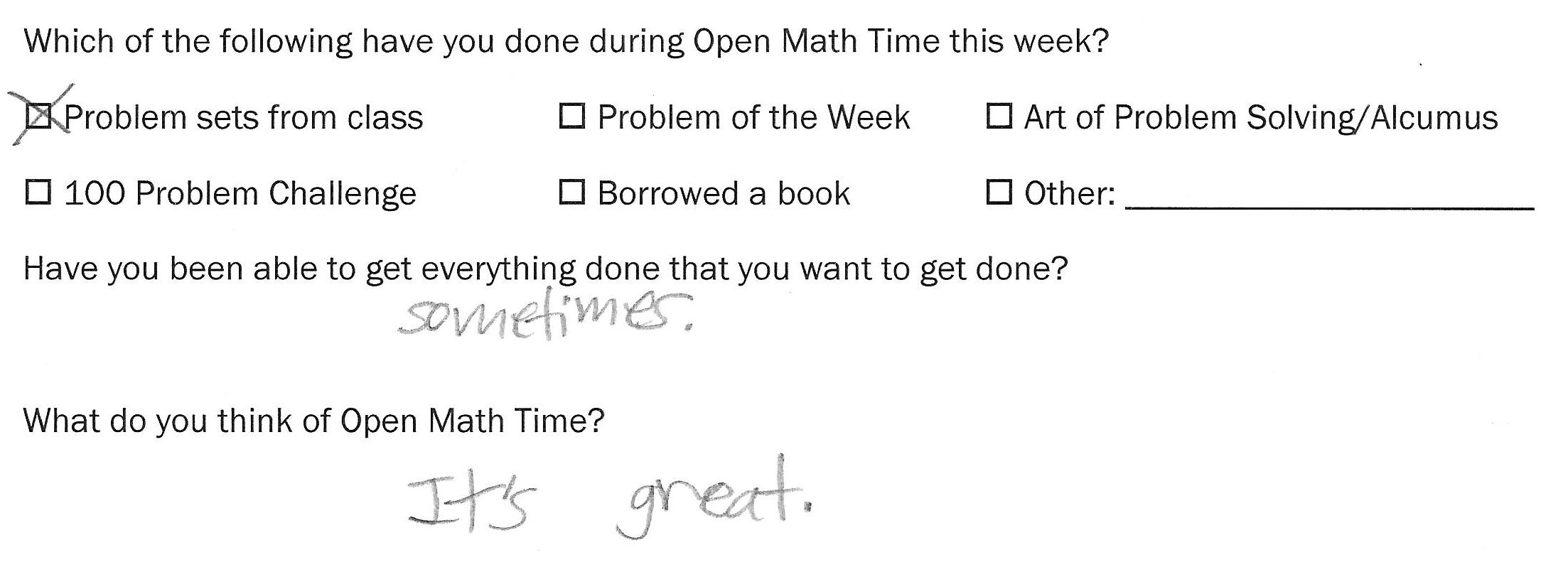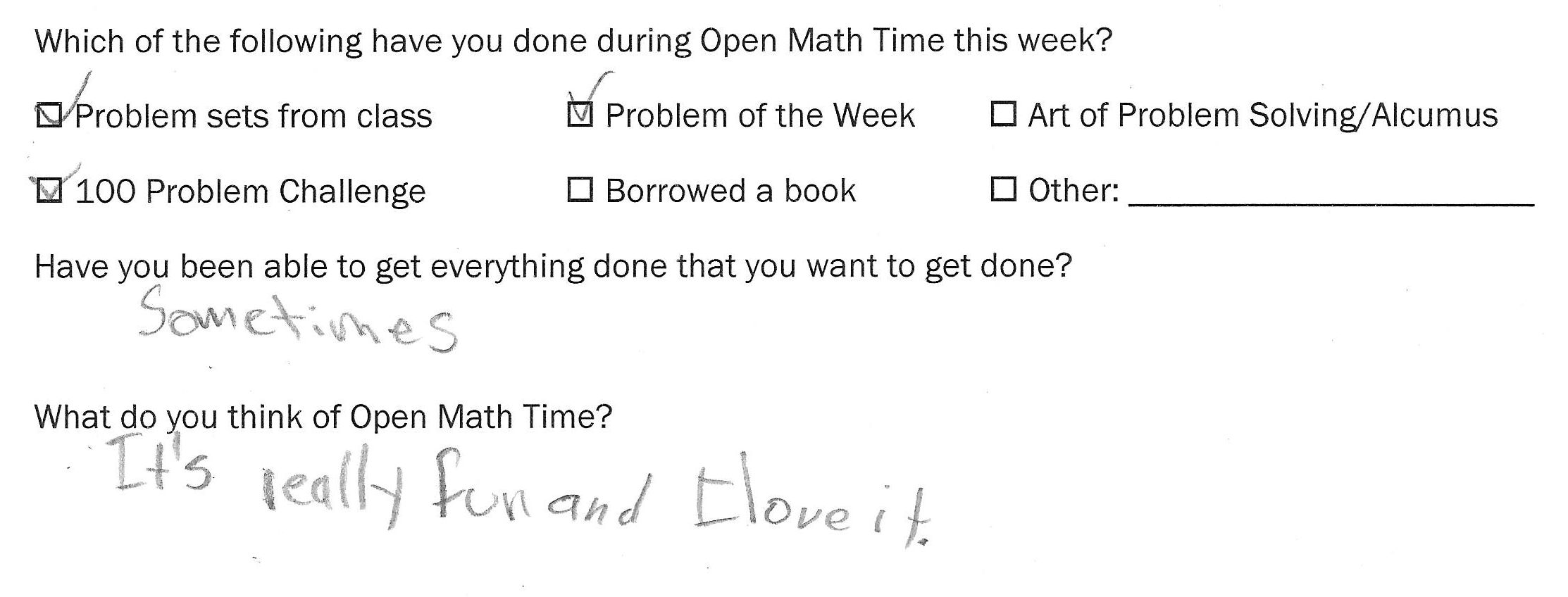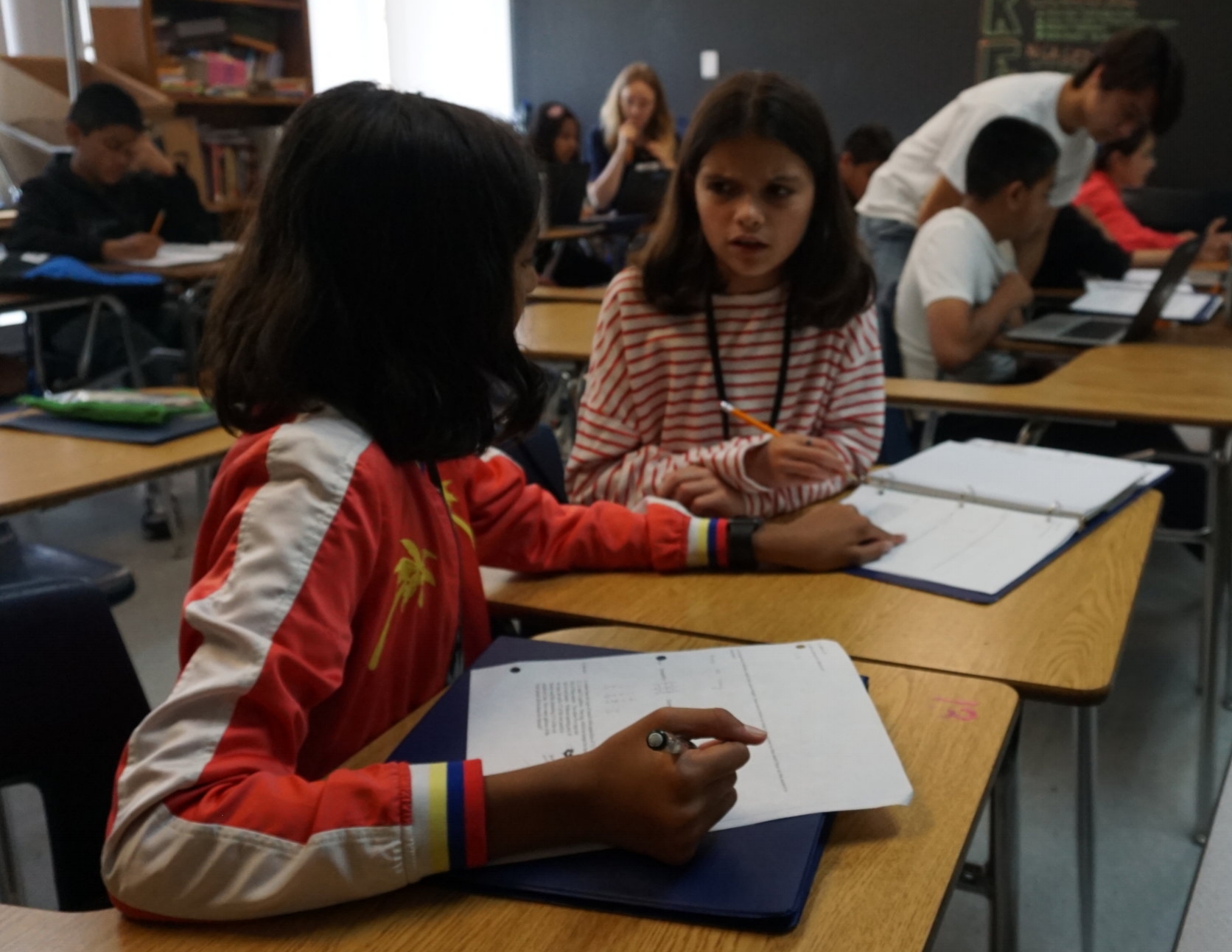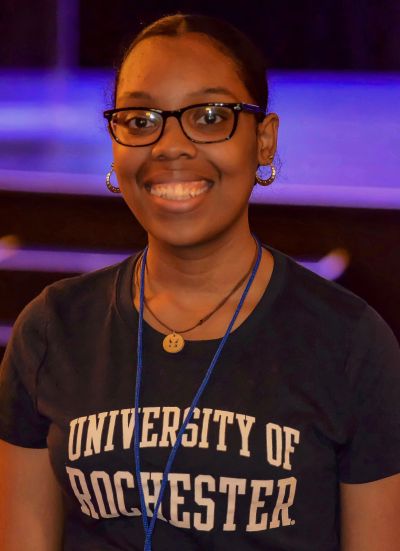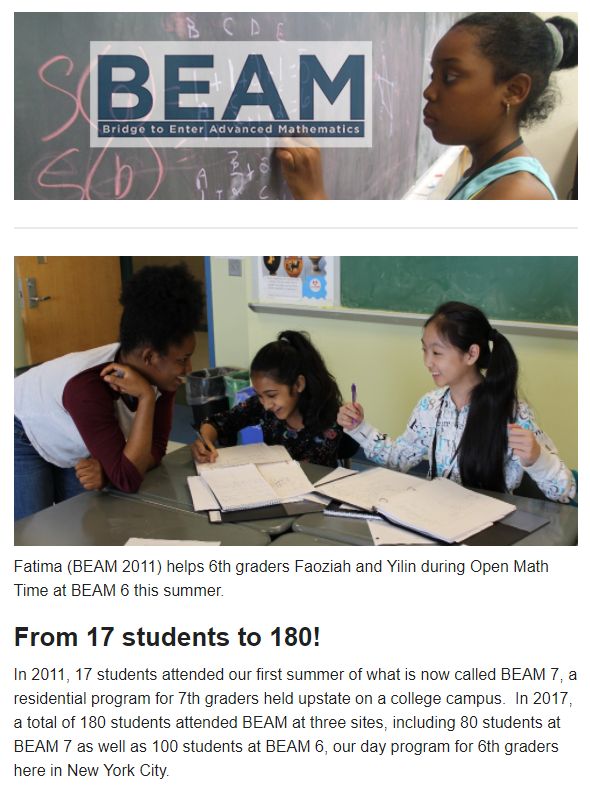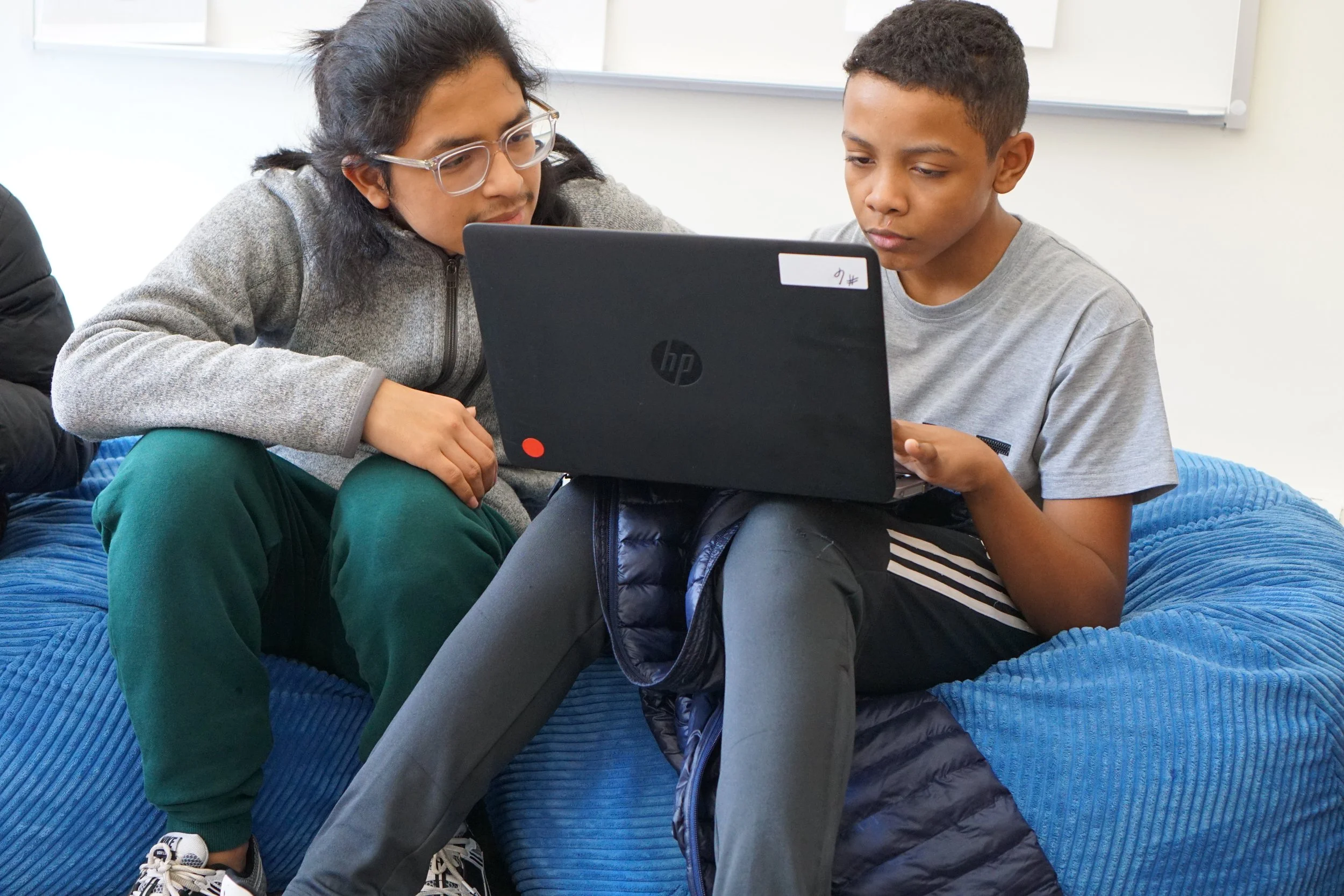
Welcome to the BEAM Blog!
Reflections on BEAM 6 LA
“Thank you for such a great experience at BEAM. BEAM has made this summer the best summer of my life. I won’t ever forget about BEAM and will keep on exploring math.”
Recently, we asked Jacob Castaneda, BEAM's Executive Director of LA Programs about the first summer of BEAM 6 Los Angeles. Here's what he had to say:
It’s hard to believe that the first summer of BEAM 6 LA is now complete. On any given day, you would see an assortment of activity: frustration and enthusiasm from problem solving, silliness during breakfast, curiosity during class, passion during Open Math Time. Above all, you could feel a strong passion for deep mathematical thinking. The program was a success, and I firmly believe that the thing that tied it all together was the students' camaraderie and the understanding that everyone was at the program to grow.
From left to right, Sharon, Daniel, Rihighna, and Valerie work on problem sets during OMT.
Clockwise from left: Emily L., Matthew, Adila, Galadriel (Counselor), Adib, Jarek working on one of the 100 Problems.
You could walk into any classroom this summer you would find students engaged in conversation around their mathematical thinking. I miss Open Math Time the most; I loved walking around and talking to groups of students collaborating on problems, having productive discussions and trying to explain their thinking to their peers.
Without fail, I could always find Sofia, Abigail A., Fernando, Oscar, Matthew, Adila, and Emily L. sitting with a counselor in the hallway outside of the trapezoid-shaped room, working on one of their problem sets or some other interesting puzzle.The music room had a high-energy group that liked to verbalize their solutions to problems, especially when twins Brissia and Rubi worked with Angel.
David (right) and Erick A. (middle) solved one of the challenge problems, so Meghan (left) writes their names on the poster.
Sometimes, Oscar would break from the trapezoid crew to work with Adib and Jarek on one of the remaining problems from the 100-Problem Challenge. Nearly half of the challenge problems were solved by groups of 2 or more students!
Faculty members also played an essential role in creating a strong community of mathematicians. Sam, our cryptography instructor, had students work in groups for weekly scavenger hunts whose clues were only readable through deciphering some code using a decryption technique learned in class. Diana had her math fundamentals class work in teams to analyze and interpret translations in Euclidean space. A math professor from Harvey Mudd visited our combinatorics class and was moved by the teaching strategy employed by Javier, the instructor. In that class, students were presented with a combinatorial pattern and asked to develop a conjecture and share it with their classmates, forming groups based on common reasoning and working to validate or invalidate others' conjectures.
Math relays, held every Friday afternoon, gave students a chance to work in teams to solve challenging math problems. Staff members selected which students worked together, giving students an opportunity to work with new people each week. It was an absolute joy to see mixed groups work together, often for the first time, and achieve success with the problems. The buzz during Relays was palpable, and students were encouraging towards one another, even when they weren't on the same team.
It's great to see the excitement about BEAM spill over into the start of the school year. We've received several submissions for the first challenge set and interest for pre-algebra classes. We expect to continue the mathematical momentum during our next math competition, set to take place in early November.
The unity among students was evident throughout the program. They supported one another in problem solving, combining their efforts to arrive at solutions. It was clear that the BEAM 6 community boosted the confidence of several students and left a lasting impression on their math journey.
But don’t take my word for it! Here’s what our summer students had to say about their experience at BEAM 6:
On the topic of Open Math Time, Rubi says "It was cool because I got to work with other people."
Rubi is a student at New Open World Academy.
"I feel more confident in myself."
Edilson is a student at Alliance Richard Merkin Middle School.
"I've gotten smarter & it's easier to work in groups."
Cherokee is a student at UCLA Community School.
"I achieved learning new things. I can apply the things I learned here in school and maybe even teach my friends at school about the things I learned."
Jamie is a student at the New Open World Academy.
"At first, I didn't felt [sic] like going to BEAM but then you supported me and I got accepted. Now I feel like BEAM is a family to me. Thank you."
Daniel is a student at Young Oak Kim Academy.
4 for 15: An hour of class at BEAM 6 Uptown
This month, we're welcoming three new full-time staff to BEAM! One of them, Alyssa Loving Jung, is BEAM's new Development and Communications Coordinator. She spent her first week at BEAM visiting BEAM 6 and wrote this blog post about her experience. Welcome to the team, Alyssa!
----
My goal is to sit in on four of BEAM 6 Uptownʻs math classes in a single hour. While I may have an advanced degree in mathematics (a Master's to be precise), it is an ambitious plan. I am eager to see what mathematics the BEAM 6 students will be tackling today.
----
To start off, I get to join the very beginning of a class that appears to be about exponents… or maybe number theory? I am not quite sure. On the board there is a question that immediately catches my eye.
What is the ones digit of 569,423^22?
I can't help it. I immediately start scribbling work in my notebook trying to solve the question. But as discussion swirls around me, I am pulled away from my attempts to solve the problem, curious as to what the students are coming up with. Students wonder out loud how to deal with a problem like this without doing a dizzying degree of multiplication. The instructor, Juan, offers a friendly warning that such an approach would take much more time than they have in class. Returning to my page of notes, I gather from my own work that the key to the problem lies in spotting a pattern and not getting lost in the cumbersome calculations.
Emily works during class.
Around me, I can hear students closing in on the pattern, and it is such fun that I must force myself to remember that I only have 15 minutes at most with them before I have to head to the next class.
Even before my time is up, one of the students is up at the board presenting an idea.
Collaborative mathematics, the courage to expose a budding solution, a still green idea, to an entire class of peers, is a crucial element of pursuing advanced mathematics. I am delighted that BEAM students are engaging with each other and their faculty like this. But glancing at the clock, I must tear myself away and head to the next class.
----
Here there is a very different sort of picture on the board.
There are intersecting circles drawn and numbers scattered about. A student is at the board placing a number with care. While the numbers seem haphazardly distributed at first, the thoughtfulness of the student is the first clue that something more is going on. Then I notice the labels: factors of 6, multiples of 6, primes.
They are exploring logic. The strange picture on the board I recognize as a Venn Diagram, a way to visualize the overlap and interplay between different sets.
They move on from the Venn Diagram on the board to start working on a sheet of problems. A student notices ambiguity in one of the problems. The problem asks them to explore the statement "not A or B". He wonders if the instructor, Sian, means "(not A) or B" or rather "not (A or B)".
The whole class takes time to investigate this subtlety. The process reminds me of writing math proofs during graduate school. Oftentimes the tiniest turn of phrase, the most minute missing detail, can make or break a complex mathematical argument. I am excited to see that the students are taking such care with the reading and writing of mathematics. But it is time for me to move on to my third class.
TA Amaya works with student Karen on a problem set during Open Math Time.
----
Yorlan works on an advanced geoemetry problem.
This class says Geometry and Logic in the corner of the chalkboard at the front. Apparently, it is another class on logic, but now there is geometry thrown into the mix. I am intrigued.
The instructor, Xavier, is energetic and he calls each student by name as he peppers the room with questions.
He wonders how we can figure out what c is when we know c^2=8. A student calls out that c is the square root of 8.
Xavier follows up, smiling, to see if Eduardo was just guessing, but no:
"No, I didn’t guess..." Eduardo responds, "It's 'cause taking the square root is the opposite of squaring something."
I am impressed that in one sentence Eduardo has gotten at the heart of what mathematicians mean by inverse equations. It is a concept that can confound even college students. But I can’t stay for more insights today.
----
I am off to my final class. As I slip into my seat, I am startled to see scrawled across the board: "Are there Aliens in the Milky Way?"
A massive equation containing many letters is sprawled somewhere beneath it. The students are clearly in the process of grappling with the equation and what it means. The instructor, Susan, asks them to replace L = (1/10)^8 in their previous calculation, with L = (1/10)^2. Immediately, diligent pencil-scratching begins, heads bent, eyebrows furrowed with concentration.
This is what I call the "dirty work" of mathematics. Complex computations don’t encompass what mathematicians do. Mathematicians are much more than mere human calculators after all. But such calculations do form an important aspect of the job of many mathematicians and scientists. BEAM students in this class are building the patience and the stamina to handle even very complex formulas, and learning some mind-boggling astronomy at the same time.
Taro, a TA, observes Jamal as he contemplates a large numbers.
Meanwhile, I have set a new personal record for how many classes I have attended in one hour, and better yet I have had the chance to think about some really cool math. I cannot wait for what the next hour of BEAM 6 has in store!
----
Curious about the classes that Alyssa visited? BEAM 6 students all take classes in our four topic areas: Math Fundamentals, Logic, Math Team Strategies, and Applied Math. Within each topic, students get to choose from a menu of classes, so they each take a class that inspires their curiosity. In the mornings, when Alyssa was visiting classes, students were in either their Math Fundamentals class, which explores the why of elementary math, or Logic class, which focuses on how to justify your reasoning. Juan and Susan were each teaching Math Fundamentals courses, while Sian and Xavier teach courses in the Logic track.
Here are the full course descriptions for the four classes she visited!
Exponents: The Super-Powers of Numbers! (Juan)
Using the power of multiplication, we will build some really, really big numbers and compare them to see which ones will turn out to be the biggest. We'll also explore a strange planet which only has 11 numbers in it!
Cryptarithms and Other Arithmetic Puzzles (Sian)
If A + B = AC, then what is A + B + C? Cryptarithms are math puzzles where the arithmetic is simple but the "thinking part" of the puzzle is challenging. We will start with simple problems and build up a tool chest of logic strategies for solving these problems and all math problems.
Geometry and Logic (Xavier)
Ever look at a problem and not know where to start? This class will develop your ability to solve complex problems. We will learn how seemingly incomplete information can be combined to form complete solutions.
Big numbers, Small numbers, and In between (Susan)
Imagine you have a very long number line, with every number you’ve discussed this year in school on the number line. A new number is introduced. Where does it go? Are you sure? In this class, we will use a variety of tools (brain power, rulers, logic, and more) to identify the big numbers, the small numbers, and the ones in between.
Learning The Game: Po-Shen Loh's Guest Talk at BEAM 6
Po-Shen Loh, mathematics professor at Carnegie Mellon University, coach of the U.S. Math Olympiad team, founder of Expii, and self-professed math enthusiast, takes the stage at BEAM 6. His audience is the nearly one hundred 6th grade students that make up BEAM 6's Uptown site, along with their counselors, a mix of college students and high schoolers, and the faculty and staff members that run the program.
Po-Shen exudes energy, and it is clear that the BEAM students are prepared to match his exuberance. When he calls for four volunteers, there is an immediate, delighted clamor to be chosen. Amid a tumult of waving hands, the four lucky ones join Po-Shen at the front.
The student volunteers stand on the stage, two on either side of a waist-high table. Each pair has one die between the two of them. Each person has one responsibility. One of them will role the die, the other will check the number for their team. The rules of "The Game" are simple:
- Each team has 4 rolls.
- After each roll, they switch dice.
- After each roll, they add their number to the numbers previously rolled.
- Whoever has the highest sum at the end wins The Game.
Po-Shen along with Nashle, Crisbelly, Angel, and Amire
Is The Game fair?
Po-Shen drops the question like a firecracker. The room explodes with excitement.
Ideas dance like dice. Laughter bounces, loud, off the walls. Counselors smile and gently shush. Po-Shen grins and throws his arms outward in a gesture that embraces the raucous enthusiasm. He brings his hands together drawing the room back to focus, channeling the bountiful energy, creating a space for solutions to be spoken.
Hands shoot up like rockets. He sifts through, shifting from one student to another, piecing together a pattern, a picture. He grabs a question from one student, an answer from another. All of it guides us towards unraveling the mathematical mystery of whether The Game is a fair one or not.
But scarcely have we settled on an answer to that question, when Po-Shen poses another.
Could there possibly be a strategy to such a game?
Strategy is such an intriguing word. It practically brims with adventure. But how could dice be thrown with strategy? Arenʻt dice devices of chance? What cherished games might be upended by the notion of a strategic dice throw?
Po-Shen introduces a key element to The Game as he is playing it, which changes the strategy. Have students noticed anything about these dice? How are standard dice constructed? Students note that they tend to have numbers that sum to 7 on opposing faces: 1 is directly opposite 6, 2 is opposite 5, 3 is opposite 4. Why? It turns out that Po-Shen has dice with 1 facing 2, 3 facing 4, and 5 facing 6. How does this change the game? Why did Po-Shen manufacturer such dice? (We'll leave that question open for you to figure out, but it turns out that the answer transforms this game from a game of chance into a game of strategy.)
Some of the BEAM students in the room were especially intrigued by the strategies that Po-Shen explored with them.
Amire, one of the four BEAM students to play the game, said "I was amazed that there was a strategy. That really amazed me." In fact, when I asked him what his favorite thing about the talk was, he answered, "Learning the strategy. Now I know how to win Monopoly."
Deanna
For Deanna, one of the BEAM students in the audience, the element of strategy was also memorable. "It was interesting, because he talked about strategies. It was complex because it was something I personally didn't know about." In talking about Po-Shen, she says, "He was interactive."
Po-Shenʻs excitement as he shared his game, his questions, and his strategies with the students was tangible. Ultimately, what he communicated was a genuine love for mathematics.
Amire, who grew animated just as he recalled the talk, said this about Po-Shen: "He is really good at math and he likes it." Amire contrasted this with people who may excel at math, but donʻt enjoy it. The fact that Po-Shen enjoyed his work as a mathematician was not only evident to Amire, it was important.
As he spoke to us, Po-Shen himself looked beyond skill in mathematics. While his confidence in the mathematical prowess of his audience seemed as clear as his beaming smile, he closed his talk asking for even more than that.
"Math is power," he said.
"Now that you have great power, you must use it for good."
There's a lot going on at BEAM 6 NYC!
BEAM 6 NYC has been underway for three weeks, and the students and staff have a lot to show for it! Since the first Monday, binders have been decorated, balls have been spiked, mafia members have been investigated- and that’s all just in activity periods!
For staff members, the fun started a week before the program for setup where they turned New Design High School (NDHS) into the official BEAM 6 Downtown site. There they taught each other new strategies for problem-solving and how to support students throughout this five-week program.
The program officially kicked off officially on Monday morning when the students met with their travel groups (or traveled alone) and came to NDHS. Upon arrival, the students got to know each other, the staff, and an overview of the program.
Throughout the rest of the week students were able to experience four types of classes that they’ll be in for the rest of the program; Logical Reasoning, Math Fundamentals, Math Team Strategies, and Applied Math. Each of these topics have different instructors and each instructor teaches a different course, so there’s never a dull moment during lunch when the students talk about what they learned earlier that day.
All in all the students have had a great start of camp and made connections that will last them throughout the program, and hopefully throughout life!
Check back soon for another post soon: Staff profiles!
What do 6th graders love about BEAM? Open Math Time!
With BEAM 6 Los Angeles' first two weeks in the book, we thought we'd take a minute to talk about one of the students' favorite parts of the day: Open Math Time! Every day at BEAM 6 includes four hours of academics: two hours of class and two hours of Open Math Time (OMT). During OMT, students choose from a menu of options, or propose their own work. They can do basically anything mathematical! Students can work individually or in groups; as long as the time is productive, any arrangement is fair game! OMT exists for a number of reasons:
Zavier (BEAM '11), right, supports students in a BEAM 6 LA classroom.
- BEAM classes don't assign homework, because it just doesn't seem right for a summer program! But, it's important to practice new ideas to really learn them. So, students use some of their OMT for short, required Problem Sets (PSets) from each class.
- BEAM believes in flexibility and choice. We want students to build the best possible summer for themselves!
- Middle schoolers are learning a lot about themselves. Students may never have been given the flexibility to choose their groupings or tasks. This is a huge opportunity for growth.
- Strong mathematicians become stronger by spending more time on math. By sharing with students the joy of self-paced, self-directed learning, we give students the tools they need to challenge themselves to learn independently.
Ever since our first summer of BEAM 6, students have raved about OMT. It becomes many students' favorite part of the day. And our BEAM 6 LA 2018 students are no different! Here are some reviews from our early program survey:
As you can see from the check boxes. students have a suggested menu of options for how to spend their OMT. Most students chose the following options:
PSets From Class
Every member of the faculty gives students about 15 minutes worth of extra work at the end of each class in the form of problem sets. Problem sets (PSets) are designed to help students practice and solidify new skills, extend understanding, and explore curiosity. For example, a student in a KenKen class might solve a more challenging puzzle, while a student learning to program in Python might add a new command to the program they're writing. Students working on PSets can head to their teacher's classroom to chat about the work and ask for support.
Want a flavor of a PSet? Here are some sample problems from two of our classes:
Exponents: The Super-Powers of Numbers
Find a number with five or more digits, all 0s and 1s, that is 7 in Z11 (in other words, it has a remainder of 7 when divided by 11).
Voting: How to Run a Country
A group of 4 friends want to do the same activity during activity time. Their options are to do any of the following: soccer (S), drama (D), frisbee (F), board games (B), or painting (P) and they decide to use Borda Count to decide the activity they should do. Consider the table of preferences below:
a) 5 points are assigned to a 1st place vote, 4 points to a 2nd place vote etc. What activity is the Borda count winner in this instance? (Make sure to give the Borda scores to justify your answer).
b) Is it possible for only one person to changing their ranking (in any way) so that painting is the only Borda count winner? If so, give the person and their new ranking and the new Borda counts of each alternative. If it is not possible, thoroughly explain why it is not possible.
100 Problem Challenge
Students work on a problem during OMT with their counselor Paula, right under the 100 problem board.
This is exactly what it sounds like: a hundred problems selected by Dan Zaharopol (BEAM Founder and the Executive Diretor of the Art of Problem Solving Initiative, Inc.) to challenge the students mathematically and bring them just to the edge of mathematical proof. There’s a big board with 100 spaces for the 100 problems, and we write in the names of students who’ve completed problems. If all 100 are solved before the end of week 5, the entire program wins a prize!
Try out a sample problem for yourself:
Problem 1
A friend tells me that she has three children, and that if you multiply their three ages you get 72. “I don’t have enough information to figure out how old they are!” I reply.
“All right,” she says, “if you add their ages, you get the street number from my address.”
I know where she lives, so I do some calculations. “I still don’t know how old they are!” I reply.
“Well,” she replies, “the oldest is really good at chess.”
Now I know how old they are. How old are her children, and what is her street address?
The state of the 100 problem challenge at the end of week 1.
Art of Problem Solving/Alcumus
Students, hard at work!
Another major goal of BEAM is that our students (new to enrichment math) have access to the same resources and opportunities that other middle schoolers all over the country already have! So, we connect them all with accounts for the Art of Problem Solving (AoPS), and encourage students to start with Alcumus. Alcumus is a free, self-paced tool that works students through math skills, starting at pre-algebra. It's fun and it's something students can use for years to come!
Becoming familiar with AoPS and Alcumus know will have major benefits to BEAM 6 alums during 7th grade, as AoPS offers a free, online pre-algebra course to any BEAM 6 alum who completes the Alcumus pre-work to demonstrate to BEAM that they plan to take the course seriously. And as our students age, we sign individual students up for AoPS classes whenever they need an enrichment boost, and are looking to challenge themselves (the combinatorics and number theory classes are a particular hit!).
We're so glad students are enjoying OMT and the rest of BEAM 6. It's clear that BEAM 6 Los Angeles is off to an incredible start! Want to read more? Check out what our own Executive Director, Dan Zaharopol, had to say on his blog:
A Day in the Life of BEAM 6
It's Friday which means we are nearly 20% of the way finished with BEAM 6 Los Angeles 2018. Where did the time go??
So, what is a week like at BEAM 6? Each day features:
- Breakfast
- Morning class
- Open Math Time
- Activities
- Lunch
- Afternoon class
- Open Math Time
- Activities
Let's dig deep on each of those blocks!
The day begins with a balanced breakfast, served a la carte in the cafeteria.
Academics
Then, it's off to class! Students at BEAM take four classes, one each in the following tracks: Logical Reasoning, Math Fundamentals, Math Team Strategies, and Applied Math. At the beginning of the summer, students selected which version of each class they wanted to take. Their options were:
- Logical Reasoning:
- KenKen Puzzles and More
- Ultimate Brain Puzzles!
- Elementary, My Dear!
- Liars, Truthtellers, and More
- Math Fundamentals:
- Fractions and Food
- Exponents: the Super-Powers of Numbers
- Patterns, Lines, and Number Rules
- Applied Math:
- Introduction to Cryptography
- Voting: How to Run a Country
- Computer Programming
- Math Team Strategies:
- Using Patterns to Solve Problems
- Counting Without Counting and Fantastic (Number) Beasts
- Words, Meet Numbers: An Algebra Story
Don't those sound fun? How did students choose?? Each instructor gave a course description and a sample problem! Here's one set to consider!
Elementary, My Dear!
Course Description:
Ever wonder how detectives like Sherlock Holmes solve complicated mysteries? It's all in the details. In this class we'll explore the different techniques used to solve complicated riddles and how to apply them in tough mathematical problems.
Sample problem:
Mr. Red, Mr. Blue, and Mr. White meet at a restaurant for lunch. Under their coats they are wearing either a red, blue, or white shirt. Mr. Blue says, “Hey, did you notice we are all wearing different colored shirts from our names?” The man wearing the white shirt says, “Wow, Mr. Blue, that’s right.” Can you tell who is wearing what color shirt?
Open Math Time
One of the big goals of BEAM is that students spend time doing math they enjoy! So, during Open Math Time, students get a menu of options they can pursue. We encourage students to keep going back to this menu of options during 7th grade, whenever they're looking for a challenge! During Open Math Time, students might:
- Reinforce learning from their classes with Problem Sets
- Try out the weekly challenge problem
- Work on the 100 Problem Challenge (more on that later!)
- Explore the Art of Problem Solving, probably by checking out Alcumus
Students can work independently, or in groups! It's really up to what makes each student the most productive.
Activities
Morning activities last for the whole week! They're a time to learn new skills or spend a whole week on a passion. This week's options are:
- Board Games: Old classics and new!
- Decorate Your Binder
- Watch the World Cup: Watch live and old soccer games!
- Learn to Solve A Rubik’s Cube
- Rooftop FUN: Steal The Bacon and Sharky Sharky
- Learn to Play Settlers: A trading and building board game set in the mythical world of Catan!
- Learn Dominion: A strategy card game where each time you play it’s different!
Afternoon
Then, it's on to lunch (buffet catering from local restaurants), the next class, the next block of Open Math Time, and afternoon activities, which change every day.
All in all, it's a busy, exciting day, and we'll have much more to share over the upcoming weeks!
BEAM's Pre-Summer Newsletter is Here!
Last Friday, BEAM's quarterly newsletter arrived in the inboxes of all our subscribers! The newsletter featured:
- An update on BEAM's growth (380 students at BEAM programs this summer!)
- Congratulations to our 12th graders on their college plans
- "What We're Reading"
- Updates on BEAM Los Angeles
Missed the newsletter? You can always read it online. And make sure you don't miss the next one! Sign up for our mailing list.
Advice for Your First Summer at BEAM
Recently, we sat down with some of our older BEAM students to ask them what advice they would give to new students entering BEAM for the first time. Here's what they had to say!
Zavier at All Star Code, 2015.
Zavier just finished his sophomore year at SUNY Albany where he has declared a major in computer science and a minor in art. He was a member of BEAM's first ever summer cohort: 2011. He was a Junior Counselor at BEAM 6's first summer (2016) and became of the first two BEAM alumni to work for us as full Counselors in 2017 (counselors must have completed a year of college). In 2018, he's flying to Los Angeles to staff the first summer of BEAM 6 LA. Beyond BEAM, Zavier was a member of the first ever cohort at All Star Code and he has extensive experience in coding, maker spaces, and teaching tech skills. Lots of firsts for Zavier!
What should students expect from BEAM?
Students should expect to be encouraged to learn and be challenged by the questions they're given. They should expect to have people around them willing to help them through problems whether those problems have to do with math or not. Most importantly, students should expect to have a good time. BEAM is where I met some of the good friends I have today and I still look back on that summer remembering some of the fun times that I had.
Zavier plays tennis at BEAM 7 in 2011.
What advice would you give to a student starting BEAM?
The advice that I would give to a student starting BEAM is: don't feel discouraged by hard problems and don't be afraid to ask for help. BEAM helped me realize that as we grow, things become more difficult and problems seem to require more thought. Practicing patience and deeper thinking is all part of the process.
Why do you keep coming back to BEAM?
I keep coming back to BEAM because of the supportive staff. BEAM has opened the door to a lot of opportunities for me. They helped me when I was applying to high schools, they helped me when I was looking for summer programs, they helped me apply to college, and they even helped me find a job. It feels good to know that I have people who are always willing to help me out and it motivates me to do my best!
Zavier teaches Javascript to Elvis at BEAM 6 in 2017.
Tanasia at College Decision Day, 2018
Tanasia, 12th grade, will be attending the University of Rochester in the fall where she plans to major in math. She has spent three summers at BEAM, as a 7th grade student in 2013, and then as a Junior Counselor at BEAM 6 in 2016 and 2017. During the school year, she coaches two math teams at BEAM partner middle schools, including one at her own alma mater!
What should students expect from BEAM?
The math will be difficult; you won't get it right away. You might even struggle for the first two weeks! But you'll expand how you look at math. You'll make friendships and connections that will last for a long time. It's a new, fun experience.
What advice would you give to a student starting BEAM?
Don't be afraid to ask the staff for help! Also: even with math, the counselors don't know everything. That's normal in math, not to know everything.
Why do you keep coming back to BEAM?
I love to see where the students start and where they end. They evolve as mathematicians and they can solve problems they couldn't do before. It's amazing.
Tanasia plays chess with Jack, BEAM 6 (2016)
John showing his school pride!
John just finished his freshman year at Fordham University, where he plans to declare a major in chemistry. He is also taking pre-med coursework and aims to be a surgeon. John attended Bard High School Early College and graduated with both a high school diploma and an Associate's Degree. He attended BEAM 7 in 2012, and has contributed to BEAM in so many ways since! He was a junior counselor at BEAM 6 in 2016 and 2017, he is the TA for our 8th grade Algebra class, and he works in the BEAM office as an part-time assistant during the school year. In summer 2018, he and two friends who also attended BEAM 7 in 2012 (Joel and Quentin), will be counselors at BEAM 7 Bard College. They are the first BEAM alumni to go back as staff to the exact same program they attended as students!
What should students expect from BEAM?
I was expecting math all day and not much fun. But you should expect to be in a community of math lovers. For me, the community was the thing. I enjoyed being in a space where everyone loved math, shared my interests. Expect to be in a loving, math community. Expect to be challenged. Expect to make amazing friends you'll keep for a century. Expect to have fun: trips are amazing, the food is good, activities. It's not just math all the time; it's something immersive.
What advice would you give to a student starting BEAM?
Keep an open mind. It may seem tedious to lose your summer, but you'll have fun. I was afraid the first day. So, be open. Step a little outside your comfort zone. Those might be your friends for the rest of your life.
Quentin (left, red cap), John (next to him), and members of the BEAM 7 community in 2012 during a karaoke activity.
When you spent that first summer with us, did you ever think you would end up being such good friends with Quentin?
He came up to me. I don't remember what he said. But ever since then, we became friends, playing basketball. BEAM helped us stay friends because they introduced us to the same high school. So I've stayed friends with him ever since. Derek, too! I didn't get to know Derek much that summer, but we became friends during high school and we still talk.
Why do you keep coming back to BEAM?
Honestly? I want to stay part of a community that's so supportive, loves math. I want to give back. BEAM helped me move in the direction I'm moving in now. I want to influence the next generation as they figure out their path. It's an amazing program, amazing community that should continue to exist and I want to help that.
The BEAM 6 group photo from 2017! Quentin (white jacket) is in the front row and John is all the way in the back. Mona, Zavier, Tanasia, and Rashik are here, too: Mona is in the front, on the left, Zavier is wearing a black cap in the middle on the right, Tanasia is in the middle, near the back, and Rashik is in the center, left with a baseball cap on.
Crisleidy at the Moth City Slam, spring 2018.
Crisleidy is graduating from Brooklyn Tech this June. She's taking a gap year next year, working at City Year (an Americorps program). During the year, she volunteers at BEAM Next, our program for 9th and 10th graders, teaching life skills (like study skills). This summer, she will be a Junior Counselor at BEAM 6 in NYC.
What should students expect from BEAM?
To step out of your comfort zone. There's a lot of new stuff. I didn't know any math, puzzle, logic games before the summer and then I got really into them.
What advice would you give to a student starting BEAM?
Learn how to play chess! There's people at the program who know and they'll teach you. Try everything once! There might be something you enjoy. But you don't have to try anything you're not comfortable with.
Why do you keep coming back to BEAM?
It's fun. I love the people. A nice community, a family. I can't get enough! Plus, I appreciate all the help I've gotten.
Crisleidy plays her favorite board game, Ricochet Robots, at BEAM 7 in 2013.
Rashik, volunteer math grading in 2018.
Rashik is an 11th grader at Bard High School Early College, which means he's currently dual-enrolled in "Year 1", the first year of his Associate's Degree. Rashik attended BEAM 7 in 2014. He was a Junior Counselor in 2017 and will be returning to that role in summer 2018. During the school year, he coaches math teams at two BEAM partner middle schools.
What should students expect from BEAM?
I think students should expect it to be an uncomfortable environment at first but once they're in the flow of things they'll love what they're learning and that they're surrounded by people that who also love what they're learning. Also, students should expect work they've never seen before: they may be confused by it, or it might take them longer than their normal math questions.
Rashik presents the solution to a challenge problem at BEAM 7 in 2014.
What advice would you give to a student starting BEAM?
The most important advice I'd give is that you have to persevere and keep working even when it gets really frustrating. There's no feeling worse than being stuck on a problem forever, but there's also no feeling better than finally solving that problem. In terms of social advice, I'd tell the kids to be themselves. There are other amazing kids at BEAM, so be brave and try to make new friends and have new experiences.
Why do you keep coming back to BEAM?
I keep coming back to BEAM partly because I made some amazing friends and that small circle still exists today. But also because the open environment that BEAM has established makes me always feel welcomed; I feel like I can go to them for any problem. I always feel like I have a community outside of school or home that I can go to for help. Plus, BEAM also takes me to Yale every year which is pretty cool.
Rashik, Eli, Tanasia, and Andy in January 2018 at our MATHCOUNTS prep event. All four of these high school students coach math teams at our partner middle schools!
Mona at BEAM College Day, fall 2016.
Mona is graduating from the Academy for Software Engineering this June. She'll be attending Barnard College as a HEOP Scholar this fall. She plans to major in mathematics with a computer science concentration. During the year, Mona is the TA for BEAM's Saturday programming class (for 9th and 10th graders). She was also been a Junior Counselor at BEAM 6 in 2017.
What should students expect from BEAM?
To have a lot of fun. Honestly. You might not expect that. Maybe your parents pushed you to do it. But it's not like school, it's fun. At the same time, expect it to be challenging.
What advice would you give to a student starting BEAM?
Be open minded. Lots of activities you might not be sure about. Don't say: I'm not good at this, I don't want to try it. Check it out!
Why do you keep coming back to BEAM?
It's a family! It's relationships. The people are easy to talk to, they make you feel comfortable. That sounds cheesy but it's true.
Mona (front) with a dozen BEAM students at our annual Slightly Mathy Trivia Night, fall 2017. Crisleidy, John, and Rashik are also pictured!
BEAM 6 Family Lunch
This past Saturday, April 29th, our new BEAM 6 students and their families attended our Family Welcome Lunch to learn more about the program. Our BEAM 6 alumni joined us to talk to families about what it's really like to be a BEAM 6 student. Kai, Lismary, Maryam, Storm and Thays talked about why they chose to come to BEAM and gave our future BEAM 6ers some GREAT advice! Read more from our experts!
question: Why did you decide to come to beam?
“Math was too simple in my school. I wanted something to challenge me.”
“I came to BEAM to learn advanced math because my school didn’t provide it.”
Question: What was your favorite part of beam?
“It was great to be in a community with other students that love math too. I’ve always loved math but was never challenged. ”
“In my school it is rare to like math. BEAM 6 allowed me to meet people that also liked math and be in a community of dedicated people.
You want students to have all the possibilities and BEAM did that for me.”
question: How is 7th grade like, After having finished beam?
“I take a regents math class and I use what I learned in BEAM 6 to answer difficult questions. ”
“Going back to my class was easy, but I also learned how to approach problems differently”
Welcome 6th graders! We are so excited to spend our summer with you.



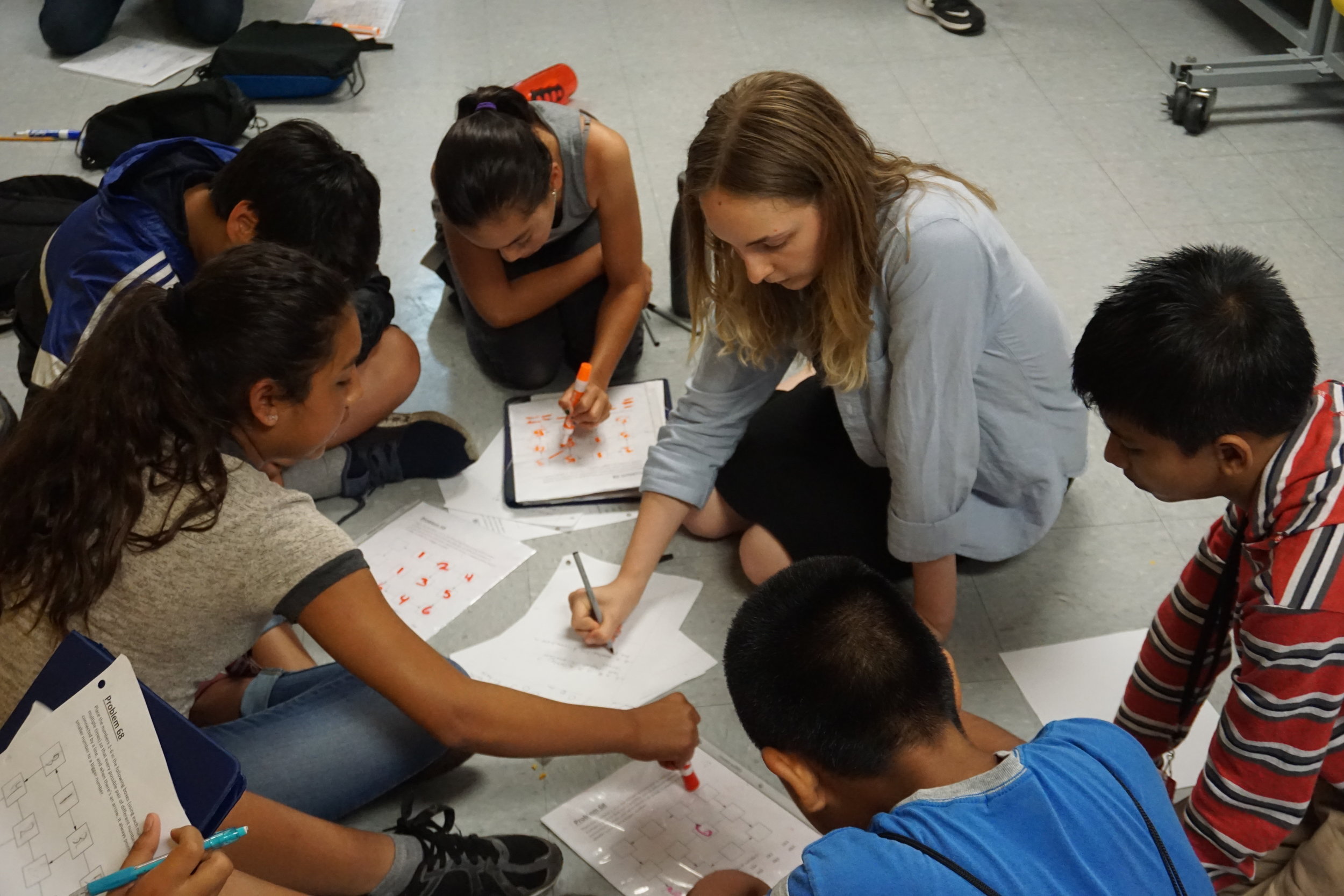










!["At first, I didn't felt [sic] like going to BEAM but then you supported me and I got accepted. Now I feel like BEAM is a family to me. Thank you."Daniel is a student at Young Oak Kim Academy.](https://images.squarespace-cdn.com/content/v1/561a6eede4b0448989c88951/1536615478385-EES7UQE1YXJJ7MF8UV5L/Daniel+P+Quote.jpg)
